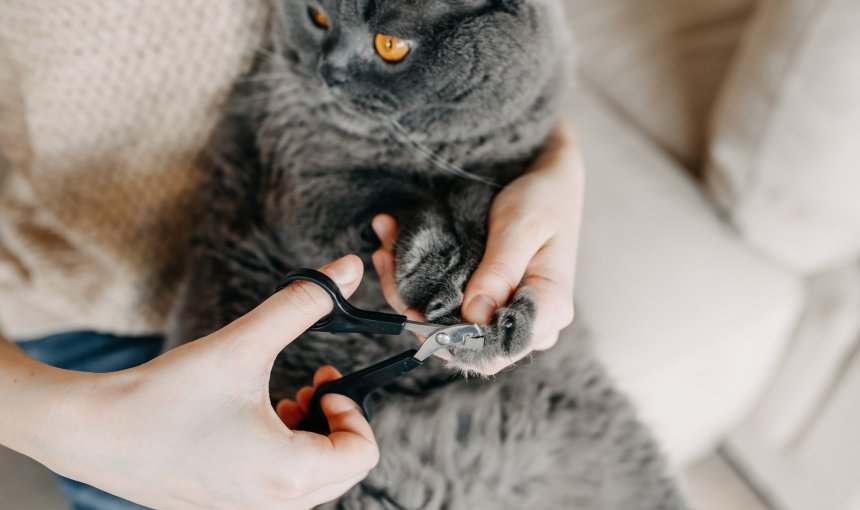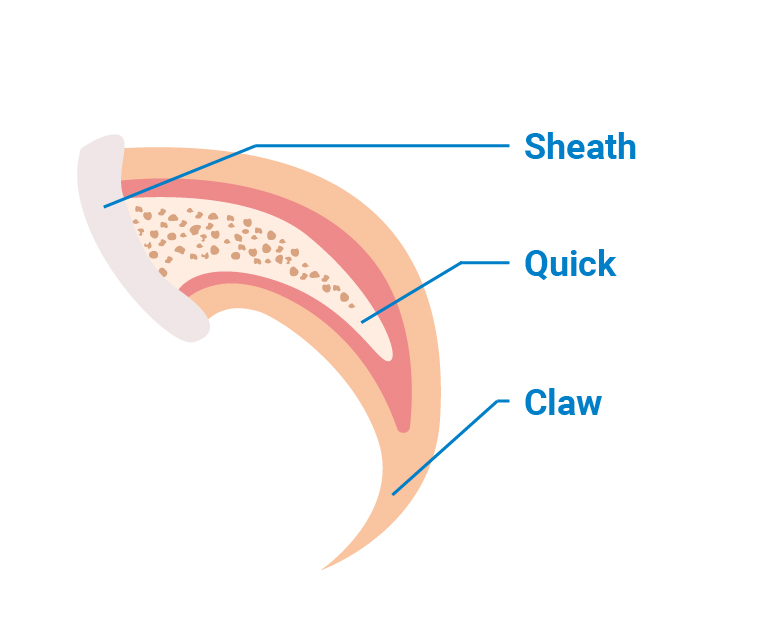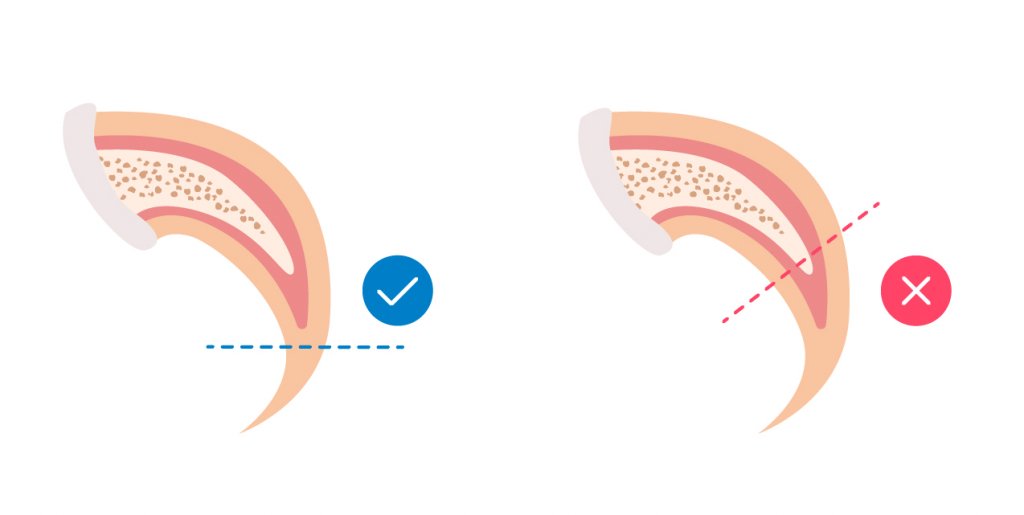How to Trim Cat Nails Safely, By Yourself & At Home
Some (though not all) cats may need their nails trimmed regularly. So here's a step-by-step guide to get started with a nail trimming routine for your cat - and how to monitor their behavior after to ensure they're okay.

While an outdoor cat’s nails are likely to get filed down naturally as they explore the outdoors, indoor or older cats often need nail care. Because if your cat’s nails get too long, they can cause injury to your furry friend – and to you too, in the form of painful scratches! To avoid that, check out our tips and tricks on how to trim cat nails safely at home – and how to monitor your feline friend for signs of pain or discomfort.

Find out where your cat spends their time.
Read more- What happens if you don’t trim your cat’s nails?
- Overview: How to trim cat nails
- Do all cats need their nails trimmed?
- How often to trim cats nails?
- How to trim cat nails: Step-by-step instructions
- Cat nail bleeding: What to do if you accidentally cut too short ?
- How to trim a squirmy cat’s nails
- My cat won’t let me trim nails – what should I do?
What happens if you don’t trim your cat’s nails?
When cat’s nails get too long, they can create problems for the cat and pose a danger to you too. Overgrown nails can catch or get snagged on clothes, blankets, and other furniture items around your house, like your curtains or carpets. This may lead to a broken nail, or other cat boo-boos. You’re also more likely to get a nasty scratch if your cat’s nails are too long.
Indoor cats with too-long nails might even experience mobility issues. Which, over time, makes them miss out on their daily movement and exercise – and which might cause them to grow overweight. Very overgrown nails may become ingrown and curl into the paw pad, which can lead to infection. And that means pain, and likely medication for your cat.
But here’s the good news: figuring out how to trim cat nails is easier than it might seem. Let’s get started.
Overview: How to trim cat nails
Most cats don’t like having their nails trimmed. While some might be more easygoing about it, you might need to gently restrain others to get them to comply. It’s why we’d always recommend you trim your cat’s nails when they’re still young – to get them used to the process. Here are a couple of tips on how to trim cat nails safely:
- Trim your cat’s nails with their paws relatively close to their body, in a position that feels natural to them. If you pull their paw out too far, their instinct will be to pull it back in.
- Using cat nail clippers or regular nail clippers, trim your cat’s nail at the tip – do NOT cut the quick (that’s the pink section of the nail). This can cause your cat pain.
- Don’t do it all in one go – aim to trim one nail a day until all nails are trimmed.
- Reinforce your cat’s behaviors (with pets, praise, and treats) when they comply.
Do all cats need their nails trimmed?
Not quite. Most cats do not need their nails trimmed1, especially outdoor cats. However indoor, arthritic, and older cats can all benefit from having their nails trimmed regularly, as they don’t get as much exercise or as many natural nail-filing opportunities as other cats. Besides, indoor cats might be more likely to scratch your furniture – as a way to stretch or get a bit more exercise. So keeping their nails trimmed can help protect your latest IKEA masterpiece or that gorgeous new curtain set or carpet you’ve just bought.
💡When in doubt, ask your vet if your cat’s nails need to be trimmed – and the best way to go about it. So you can make an informed decision whether you can trim your cat’s nails at home. (Or if it’s better to leave some jobs to the pros.)
How often to trim cats nails?
Check your cat’s paws and nails regularly to make sure there’s no signs of cuts, swelling, infection, injury or splinters. You can trim cat nails once every 10-14 days, or a bit longer if you notice they’re still relatively short.2 If you can hear your little buddy’s nails tap-tap-tapping on the floor as they totter by, it’s definitely time for a nail trimming. Doing so will help you prevent any mobility-reducing issues for your cat in the long run.
How to trim cat nails: Step-by-step instructions
Step 1: Get timing & setting right
The best is to start trimming your cat’s nails when they’re still a kitten, so that they get used to it. This will make things easier over time. Once you’re ready to start, do your best to ensure your cat is in as relaxed an environment as possible. Find a calm place to trim your cat’s nails, away from loud noises or distractions (such as other animals, or birds outside the window). You could also trim your cat’s nails when they are sleepy, or after they’ve enjoyed a nice meal. Let your cat sit on your lap, be gentle with them, and have some treats on hand. You want to ensure they build a positive association with the nail trimming process.
Step 2: Define the cutting range
Once your cat is relaxed and sitting on your lap, gently lift up one of their paws – and be careful not to move your little buddy too much. Press a toe pad between your cat’s fingers to expose the nails, like in the image below. This helps to take a closer look at claw anatomy to make sure you understand how best to trim a cat’s nails. Mainly, you’ll want to be able to identify the three key parts:
- The sheath, the outer layer which cats regularly shed off by scratching
- The quick, the inner “pink” bit full of nerves and blood vessels
- The claw, the sharp bit we’re all familiar with
This graphic might help you better picture it:

⚠️ WARNING: Do NOT trim into the quick, the pink part which holds nerves and blood vessels. This can cause your cat a great deal of pain. In the illustration below, you can see where it is safe to cut your cat’s nails – towards the bottom of the nail, and closer to the tip. Do not cut into the pink area, or you could expose your cat to bleeding and infection. It’s better to trim just a little bit than to risk cutting them at the quick.

Step 3: Trim your cat’s nails
Gently clip the tip of one nail, release your cat’s paw, and reward them with a treat. If your cat doesn’t seem bothered, you can trim a few more nails. With some cats, trimming just one nail a day may be the best you can do. As a general rule: less is more. It’s always better to ensure your cat’s safety and wellbeing (and trust in you) than try and get it all done at once.
⚠️ If your cat is agitated or upset, do not attempt nail trimming. Similarly, do not get upset or punish your cat if they are not cooperating – just try again another time, or ask a professional for help.
The sharper the nail clippers, the smoother the trimmed nail will be. After clipping your cat’s nails, you can file the nail down to prevent snagging.
Step 4: Reward your cat
After trimming, be sure to reward your cat with a treat, their favorite cat food, or plenty of petting and sweet words. That way, your cat may just begin to tolerate the nail cutting process. They might not ever grow to love the process – but they certainly can build a tolerance with time. (And trust in you.)
Step 5: Repeat
Since most cats don’t enjoy having their nails trimmed, you may need to repeat these steps each day until you’ve trimmed all of your cat’s nails. Remember to have patience, reward your cat for good behavior, and try to make the process comfortable for you both.
Cat nail bleeding: What to do if you accidentally cut too short?
In case you cut your cat’s nail too short and it starts to bleed, stay calm. To stop the bleeding, apply a styptic powder, silver nitrate stick, or cauterizing powder. (Not sure what these are? No worries. Someone at a pet store or pharmacy can guide you in the right direction.) In a pinch, you can also try using baking powder, flour, or a bar of soap to stop the bleeding. In any case, make sure to visit your vet to have the wound treated professionally.3
Most importantly, give your cat all the hugs and treats in the world to help them overcome their discomfort.
How to trim a squirmy cat’s nails
You can restrain your cat by holding them on your lap, belly facing downwards, and head facing to your side. Rest your forearms gently but firmly on their neck and behind. So you can hold them still while trimming the cat nails with your dominant hand.
My cat won’t let me trim nails – what should I do?
Since many cats do not like getting their nails cut, or are not used to the process, it may not be easy to cut your cat’s nails yourself. Your cat might try to squirm away from you, or worse – bite or scratch.
If you’ve already tried the steps above with a lot of patience, love and care, and it’s still not working, seek professional assistance. You could ask your vet to trim your cat’s nails, or look for a cat nail trimming service near you.
Remember, you’re not the only one – in fact, it’s quite the accomplishment being able to trim a cat’s nails!



